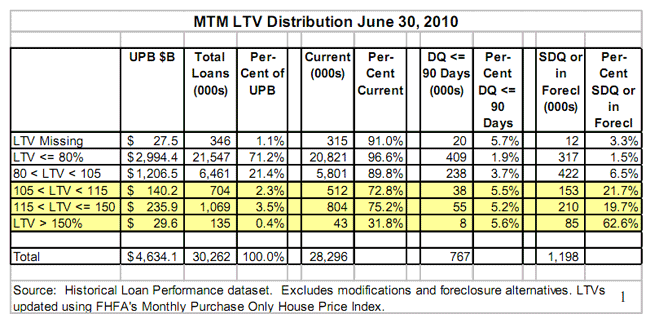Blog

DeMarco Outlines Justification against GSE Principal Reduction
Acting Federal Housing Finance Agency (FHFA)rnDirector Edward J. DeMarco responded Friday to a request from 16 HousernDemocrats to explain the statutory authority that DeMarco has claimed prohibitsrnFHFA from offering principal reduction as part of loan modifications on loansrnit owns or guarantees. The request wasrnmade last November after DeMarco told the House Committee on Oversight andrnGovernment Reform that his agency had concluded that “the use of principal reduction within the context of a loanrnmodification is not going to be the least-cost approach for the taxpayer.” When a committee member pointed out that severalrnbanks are already implementing principal reduction programs in an attempt tornhelp delinquent or underwater homeowners and citing specific examples, DeMarco said “I believe that the decisions that we’ve made with regardrnto principal forgiveness are consistent with our statutory mandate,” and committedrnto providing documentation of that statutory authority to the Committee.</p
Inrna letter sent to the Committee’s ranking member Elijah Cummings (D-MD) DeMarco laidrnout the statutory requirements as originating in three congressional mandates;rnfirst FHFA’s role as conservator and regulator of the government sponsoredrnenterprises (GSEs) which requires it to preserve and conserve the assets andrnproperties of the GSEs; second, maintaining the GSE’s pre-conservatorship missionsrnand obligations to maintain liquidity in the housing market; and third, underrnthe Emergency Economic Stabilization Actrnof 2008 (EESA), FHFAs statutory responsibility to maximize assistance tornhomeowners to minimize foreclosure while considering the net present valuern(NPV) of any action to prevent foreclosures.</p
The focus of the letter, however, is notrnthe statutory framework but rather why FHFA has decided that principalrnforgiveness does not meet its core responsibility within that framework tornpreserve and conserve the assets of the GSEs.</p
DeMarco’s rationale relies on an internalrnanalysis provided to him in December 2010 and updated in June 2011 which showsrnthat the use of principal reduction as a loss mitigation measure for GSE loansrnunder with the Making Home Affordable (HAMP) program or the FHA Short Refirnprogram would cost the Enterprises more than the benefits derived andrnrecommended that, instead the GSEs should more aggressively pursue proprietyrnloan modifications that reduce the interest rate, extend the mortgage term, andrnprovide for substantial principal forbearance and promote HARP refinancerntransactions for borrowers who are current on their mortgages but underwater inrnrespect to their equity. </p
The GSEs collectively guarantee or holdrnabout 30 million loans and, using the FHFA Home Price Index to estimate homernvalues it appears that less than two million of these loans are secured byrnproperties valued at less than the outstanding debt; i.e. underwater. Of these loans, more than half are performingrnand about one-half million are severely delinquent or in foreclosure. The table below clearly shows that high LTVrnloans are only a small proportion of the GSE’s loans and that most of the loansrnare either current or severely delinquent.</p
Using the Treasury HAMP NPV model thernFHFA study team compared the economic effectiveness of forgiving principal downrnto a mark-to-market LTV (MTMLTV) level of 115 percent versus forbearance of thernsame amount of principal for all loans with a MTMLTV greater than 115 percent. The model suggested no better result from principalrnreduction than from forbearance and showed the latter as slightly morerneffective in reducing GSE losses. Thernteam also evaluated the accounting and operational implications of thernprincipal reduction to measure those costs against benefits to borrowers. The costs were found to include, in additionrnto the immediate losses, the costs of modifying technology, providing trainingrnto servicers, and the opportunity cost of diverting attention away from otherrnloss mitigation activities.</p
Principal forbearance, inrncontrast, requires no systems changes and is a common approach in governmentrncredit programs, including FHA. The borrower is offered changes to the loanrnterm and rate as well as a deferral of principal, which has the same effect onrnthe borrower’s monthly payment as principal reduction, but provides the investorrnwith potential recovery. The forborne principal is paid in full or part uponrnsale of the property or payoff of the loan. This traditional approach wouldrnminimize the Enterprise losses and treat GSE borrowers in a manner that isrnconsistent with other government programs.</p
Given the large portion of thernhigh LTV borrowers that are current on their mortgages, a principal reductionrnprogram for this segment, such as the FHA Short Refi program, simply transfersrnperforming GSE borrowers over to FHA, at a cost to the GSEs. A less costlyrnapproach for the Enterprises to assist these borrowers is to provide a GSErnrefinance alternative, such as HARP. Clearly, the HARP program has beenrnunderutilized to date, suggesting that the program features should be revisitedrnto remove barriers to entry wherever possible.
All Content Copyright © 2003 – 2009 Brown House Media, Inc. All Rights Reserved.nReproduction in any form without permission of MortgageNewsDaily.com is prohibited.
Latest Articles
By John Gittelsohn August 24, 2020, 4:00 AM PDT Some of the largest real estate investors are walking away from Read More...
Late-Stage Delinquencies are SurgingAug 21 2020, 11:59AM Like the report from Black Knight earlier today, the second quarter National Delinquency Survey from the Read More...
Published by the Federal Reserve Bank of San FranciscoIt was recently published by the Federal Reserve Bank of San Francisco, which is about as official as you can Read More...


Comments
Leave a Comment